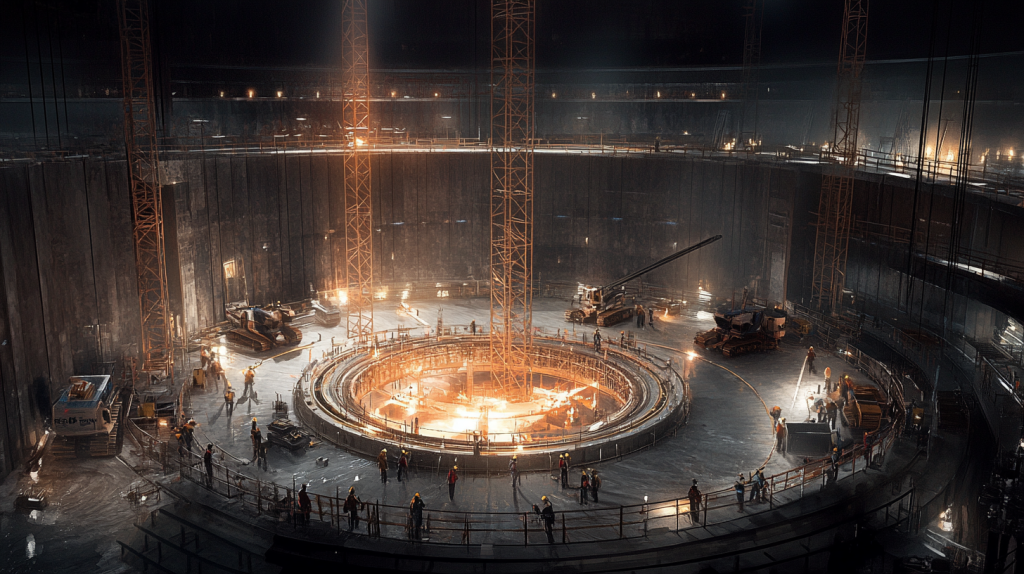Data Center Construction Scheduling: Best Workforce Scheduling Strategies to Improve Productivity in Data Center Construction
Table of Contents:

Building a data center isn’t just about pouring concrete and plugging in servers—it’s about coordinating hundreds of workers, managing tight deadlines, and making sure that every crew is in the right place at the right time. A single scheduling mishap can throw the entire project off track, leading to costly delays, inefficient labor use, and frustrated stakeholders.
Effective workforce scheduling ensures that skilled labor is optimized, resources are allocated efficiently, and project milestones are met without last-minute chaos. Whether you’re working on a hyperscale data center or a smaller enterprise facility, getting everyone on-site at the right time is crucial to keeping the project on schedule and within budget.
In this guide, we’ll break down the best workforce scheduling strategies that improve productivity, reduce downtime, and optimize labor use in data center construction. Let’s dive in!
Why Workforce Scheduling is Critical for Data Center Construction
Unlike traditional commercial projects, data center construction has strict deadlines, high-value components, and specialized labor requirements. Electricians, HVAC technicians, structural engineers, and IT infrastructure specialists must all work in sync, meaning a scheduling error in one area can impact multiple trades.
Imagine your electrical contractors arriving before backup power infrastructure is installed. Or HVAC teams being scheduled before the cooling infrastructure is delivered. Without precise workforce scheduling, misalignment between labor availability and material deliveries can cause significant delays.
Proper workforce scheduling keeps productivity high by ensuring:
✅ Crews arrive when needed—not too early, not too late.
✅ Multiple trades don’t overlap unnecessarily, preventing worksite congestion.
✅ Shift-based work scheduling keeps productivity running 24/7 for hyperscale projects.
Key Benefits
- Reduces Labor Costs – Prevents unnecessary overtime and inefficient scheduling.
- Improves Worker Productivity – Ensures skilled workers are available when required.
- Prevents Installation Bottlenecks – Matches workforce schedules with equipment deliveries.
Best Practices
- Use AI-Powered Scheduling Tools – Automate shift planning and workforce allocation.
- Integrate Workforce & Delivery Schedules – Ensure workers arrive only when materials are on-site.
- Leverage Workforce Management Software – Platforms like StruxHub Scheduling allow real-time adjustments and visibility.
Workforce scheduling in data center construction isn’t just about putting names on a calendar—it’s about strategic labor allocation that keeps productivity high, prevents delays, and ensures every crew is where they need to be, when they need to be there.
Shift-Based Workforce Scheduling for 24/7 Hyperscale Construction
Hyperscale data centers operate on aggressive construction schedules, requiring round-the-clock labor shifts to meet tight deadlines. Traditional 9-to-5 scheduling simply doesn’t cut it for multi-phase construction workflows that demand 24/7 progress.
Shift-based workforce scheduling ensures that projects move forward without unnecessary downtime. By rotating skilled labor in strategic shifts, construction sites maintain continuous productivity while preventing worker fatigue and burnout.
For example, splitting workforce schedules into three 8-hour shifts ensures that critical work never stops, while specialized crews (such as electrical teams and IT installers) are scheduled for off-peak hours when space constraints are minimized.
Key Benefits
- Eliminates Dead Time – Ensures construction continues around the clock.
- Prevents Worker Fatigue – Well-structured shifts reduce burnout.
- Optimizes High-Skilled Labor Use – Assigns skilled workers when they’re needed most.
Best Practices
- Create Overlapping Shifts – Ensure smooth transitions between work crews.
- Schedule Specialist Crews for Off-Peak Hours – Prevents congestion in work zones.
- Monitor Shift Productivity in Real-Time – Use StruxHub to track shift efficiency.
Shift-based workforce scheduling maximizes productivity, reduces downtime, and keeps hyperscale projects moving 24/7, ensuring completion within tight delivery timelines.

Matching Workforce Schedules to Equipment and Material Deliveries
Even the most well-planned workforce schedule is useless if materials and equipment aren’t available when needed. For data center construction, timing is everything—electrical crews need switchgear ready, HVAC teams need cooling systems on-site, and IT specialists need rack infrastructure in place before they can proceed.
Misalignment between labor scheduling and delivery timelines results in wasted labor hours, project delays, and inefficient resource use. The solution? Synchronizing workforce schedules with material delivery tracking.
Using real-time delivery tracking platforms like StruxHub Deliveries allows project managers to adjust labor schedules dynamically, ensuring that workers are only on-site when the required materials have arrived.
Key Benefits
- Prevents Labor Downtime – Ensures crews aren’t waiting around for materials.
- Reduces Storage Issues – Avoids excess materials piling up before installation.
- Optimizes On-Site Productivity – Keeps workflows streamlined and efficient.
Best Practices
- Use Real-Time Delivery Tracking – Ensure crews are scheduled only when materials are available.
- Create Contingency Schedules – Prepare for delayed deliveries with backup labor plans.
- Integrate Delivery & Workforce Management Tools – Connect StruxHub with material tracking platforms.
Aligning workforce schedules with delivery tracking ensures that crews work efficiently, labor costs are optimized, and installation flows seamlessly, reducing unnecessary delays and costs.
Related Articles:

Reducing Workforce Scheduling Conflicts with Predictive Planning
One of the biggest pain points in data center construction scheduling is conflicting crew assignments. When different teams—electricians, HVAC installers, IT specialists, and general contractors—are scheduled to work in the same space at the same time, chaos ensues. Overlapping work leads to delays, miscommunication, and even safety hazards, slowing down progress and increasing costs.
The key to reducing scheduling conflicts is predictive workforce planning. By leveraging historical data, AI-driven workforce management tools, and real-time job site updates, project managers can anticipate scheduling bottlenecks before they happen. AI-powered scheduling software can analyze factors such as crew availability, material delivery timelines, and project phase requirements, helping teams adjust schedules dynamically.
Key Benefits
- Prevents Worksite Overcrowding: Avoids multiple crews competing for limited workspace.
- Optimizes Resource Utilization: Ensures workers are assigned based on actual project needs.
- Reduces Rework and Errors: Keeps skilled labor focused and efficient.
Best Practices
- Use AI-Based Scheduling Platforms – Automate labor assignments based on real-time project status.
- Coordinate Between Trade Contractors – Hold weekly scheduling meetings to prevent conflicts.
- Implement Dynamic Adjustments – Allow flexibility in work schedules based on site conditions.
Predictive scheduling reduces workforce conflicts, keeps job sites organized, and ensures every team is working efficiently, leading to smoother project execution and fewer costly delays.
Using Workforce Management Software for Real-Time Adjustments

StruxHub: Revolutionizing Project Management in Large Commercial Construction
In data center construction, even the best-planned schedules can face unexpected disruptions—weather delays, supply chain issues, labor shortages, or last-minute design changes. Rigid scheduling systems don’t account for these on-the-fly adjustments, which is why real-time workforce management software is a game-changer.
With platforms like StruxHub Scheduling, construction teams can track workforce allocation in real-time, update schedules dynamically, and send instant alerts to workers when plans change. This reduces downtime, ensures workers aren’t left waiting around, and keeps contractors aligned on the latest job site priorities.
Key Benefits
- Reduces Last-Minute Scheduling Conflicts: Adjusts work assignments based on real-time updates.
- Enhances Communication Across Teams: Keeps all stakeholders informed.
- Improves Productivity Metrics: Tracks crew efficiency and shift performance.
Best Practices
- Integrate Scheduling with Project Management Tools – Connect labor schedules with real-time project tracking software.
- Enable Mobile Updates for Workers – Use mobile apps to notify crews of schedule changes instantly.
- Implement AI-Driven Workload Distribution – Prevent burnout and optimize labor allocation.
Using real-time workforce scheduling software keeps construction projects agile, organized, and highly productive, preventing inefficiencies that can derail a data center build.
Managing Shift Changes for Large-Scale Data Center Projects
For hyperscale data centers, managing shift changes and handoffs between work crews is essential to keep 24/7 progress on track. Poorly managed shift transitions lead to miscommunication, redundant tasks, and wasted labor hours, slowing down productivity.
One effective solution is implementing a structured shift changeover process, ensuring that incoming teams have full visibility into the progress of the outgoing crew. Digital handoff reports, live progress dashboards, and daily crew meetings ensure that teams don’t repeat tasks or overlook important updates.
Key Benefits
- Minimizes Productivity Loss During Shift Changes: Ensures smooth team transitions.
- Improves Accountability Across Crews: Keeps records of who did what.
- Optimizes 24/7 Construction Progress: Ensures seamless workflow continuity.
Best Practices
- Use Digital Shift Logs – Track work progress and ensure shift continuity.
- Schedule Overlapping Handoff Periods – Allow for smooth transitions between crews.
- Enable Live Progress Tracking – Use StruxHub for shift-based workforce coordination.
By optimizing shift scheduling and crew handoffs, data center construction teams maintain consistent productivity and eliminate costly worksite inefficiencies.
Related Articles:
OFCI vs. CFCI: Which Procurement Method is Right for Your Project?
Balancing Skilled Labor Shortages with Smart Scheduling
Data center construction demands specialized labor, including electrical engineers, cooling system experts, and IT infrastructure specialists. However, skilled labor shortages often create bottlenecks, forcing contractors to rely on limited resources, which can slow down timelines and increase labor costs.
One solution is smart scheduling, which prioritizes critical trades at key project phases while ensuring that available labor is distributed efficiently. Using AI-powered scheduling tools, project managers can match available workers with project priorities, preventing idle crews and misallocated labor resources.
Key Benefits
- Maximizes Productivity with Limited Labor Supply: Allocates skilled workers where they’re needed most.
- Reduces Project Slowdowns: Ensures labor shortages don’t create major delays.
- Enhances Workforce Planning for Future Phases: Allows teams to forecast labor needs.
Best Practices
- Use AI-Based Workforce Optimization Tools – Automate labor scheduling to prevent misallocation.
- Hire Specialized Contractors Early – Secure expert tradespeople before critical installation phases.
- Track Workforce Productivity in Real-Time – Use StruxHub to monitor labor efficiency.
By addressing skilled labor shortages with smart workforce scheduling, data center projects stay on track, within budget, and free from unnecessary slowdowns.

StruxHub
Experience the power of StruxHub today and witness firsthand how it can revolutionize your construction operations.
Unlock the Full Potential of Your Construction Projects with StruxHub
StruxHub enhances efficiency and coordination across all project phases, providing a single source of truth that eliminates silos and fosters collaboration. Real-time updates, financial management tools, and seamless commvunication features ensure that all team members and stakeholders are aligned and informed, reducing the risk of errors and delays. With comprehensive solutions for document management, risk mitigation, and quality control, StruxHub maintains project integrity and safety, while mobile access and integration capabilities further enhance project flexibility and efficiency.
StruxHub’s Key Features and Benefits:
- Advanced Delivery Management: Automate and optimize your delivery schedules, ensuring materials arrive just in time, every time.
- Site Communication: Utilize georeferenced maps and instant messaging to keep every team member informed and aligned.
- Construction Materials Management: Track inventory levels and manage materials procurement with ease, reducing waste and avoiding project delays.
- Construction Safety & Inspection Workflows: Implement customizable mobile forms for conducting safety inspections and managing compliance documentation effortlessly.
- Short-Term Scheduling: Visualize project tasks with detailed floor plans, linking each activity to specific locations for better planning accuracy.
- Construction Resource Management: Efficiently allocate personnel and equipment, maximizing productivity and reducing idle time.
StruxHub’s Product Offering:
- StruxHub Deliveries: Simplifies the coordination of incoming deliveries, ensuring materials and equipment are precisely timed to project needs.
- StruxHub Logistics: Offers intelligent site logistics planning, from crane scheduling to space allocation, for smoother operations.
- StruxHub Safety: Elevates on-site safety standards with easy-to-use tools for inspections, permits, and incident reporting.
- StruxHub Scheduling: Enhances project timelines with intuitive scheduling tools that ensure tasks are completed efficiently and on time.
With StruxHub, construction companies can look forward to a streamlined, more efficient project execution that delivers on time and within budget. Embrace the power of innovation and take your construction projects to the next level.
Don’t miss out on the opportunity to optimize your construction management processes with StruxHub. Sign up for a free demo today. Let’s build smarter, together.

StruxHub
Discover how StruxHub can revolutionize your construction management. Contact us today!
FAQ
How does workforce scheduling impact data center construction efficiency?
Workforce scheduling plays a critical role in data center construction efficiency. Without a strategic scheduling approach, even the most well-planned projects can face costly delays, resource mismanagement, and wasted labor hours.
One of the biggest challenges in data center construction is coordinating multiple trades working on different aspects of the project—electrical contractors, HVAC specialists, IT infrastructure teams, and structural engineers. If these teams aren’t scheduled properly, worksite congestion and resource conflicts can slow progress. For example, scheduling electrical contractors before power infrastructure is installed can leave them idle, leading to increased labor costs and decreased productivity.
To improve efficiency, workforce scheduling should be dynamically adjusted based on real-time job site conditions. Platforms like StruxHub Scheduling enable automated scheduling updates, helping managers ensure that workers are available when needed and avoid unnecessary delays. By integrating labor schedules with material deliveries, teams can ensure that workers aren’t waiting for materials to arrive before they can begin their tasks.
Additionally, shift-based workforce management ensures that projects progress 24/7 without overworking staff. This is especially important for hyperscale data center projects, where construction deadlines are extremely tight and continuous work cycles are necessary to meet completion targets.
Ultimately, efficient workforce scheduling leads to higher productivity, lower labor costs, and better project outcomes, ensuring that construction stays on track and within budget.
What are the biggest workforce scheduling challenges in data center construction?
Scheduling a workforce for a data center build isn’t as simple as setting a 9-to-5 shift and calling it a day. There are multiple challenges that construction managers face, including trade conflicts, unpredictable labor availability, last-minute design changes, and poor alignment with material deliveries.
One of the most common issues is overlapping trades working in the same space at the same time. For example, HVAC installers might be scheduled to install cooling systems, while electrical contractors need access to the same area to set up power distribution units. This results in worksite congestion, delays, and potential safety hazards.
Another major challenge is supply chain unpredictability. Even the most well-planned schedules can be derailed by late material deliveries or incorrect shipments. If a shipment of electrical switchgear is delayed, electricians scheduled for installation may be forced to wait, leading to wasted labor hours and increased costs.
To overcome these challenges, construction teams should use AI-powered scheduling tools like StruxHub that can dynamically adjust workforce schedules in real-time based on changing conditions. By integrating scheduling platforms with delivery tracking systems, project managers can automate scheduling updates and ensure that workers are assigned to tasks only when materials are available.
Additionally, flexible labor scheduling helps reduce downtime by ensuring that specialized workers are only on-site when needed, and that backup labor resources are available for unexpected delays.
How can predictive scheduling improve workforce efficiency?
Predictive scheduling leverages AI and historical workforce data to optimize labor allocation, prevent scheduling conflicts, and anticipate project delays before they happen. Unlike traditional scheduling methods, which rely on static planning and manual updates, predictive scheduling dynamically adapts to real-time project needs.
By analyzing historical trends, workforce productivity data, and supply chain analytics, predictive scheduling tools can forecast potential bottlenecks before they impact the project. For example, if past data shows that a specific phase of construction typically takes 20% longer than planned, AI-driven scheduling software can automatically adjust future schedules to compensate for this delay.
One major benefit of predictive scheduling is its ability to optimize shift planning. If AI detects that worker productivity drops significantly after eight-hour shifts, it can recommend staggered shift rotations to maintain efficiency without overworking staff. This is particularly useful for hyperscale data centers, where projects operate on 24/7 construction schedules.
Furthermore, predictive scheduling allows project managers to prepare for labor shortages by identifying peak demand periods and ensuring that backup resources are available when needed. Platforms like StruxHub integrate predictive scheduling with workforce analytics, helping teams adjust labor plans dynamically.
In short, predictive scheduling reduces downtime, prevents delays, and ensures that workforce resources are used efficiently, making it a game-changer for data center construction.
What role does shift-based scheduling play in hyperscale data center construction?
Shift-based scheduling is a must-have for hyperscale data center construction projects, where tight deadlines require continuous progress to meet operational launch dates. Instead of traditional day-shift-only construction, hyperscale projects run on 24/7 work cycles, requiring well-planned shift rotations to maintain steady progress without causing worker burnout.
A well-structured shift schedule ensures that critical tasks continue seamlessly, even when transitioning between work crews. For example, electrical contractors working on power distribution units might finish their shift just as IT infrastructure teams arrive, preventing gaps in work and ensuring that installation flows smoothly.
Effective shift-based scheduling also reduces labor fatigue and safety risks. Overworked crews are more prone to errors, accidents, and productivity slowdowns. By implementing 8- to 12-hour rotating shifts, teams can maintain consistent progress while ensuring worker well-being.
To keep shift transitions smooth, construction teams use digital shift logs and workforce management software like StruxHub to track progress between shifts, ensuring that each crew knows exactly what was completed and what still needs to be done.
Ultimately, shift-based scheduling allows data center construction to stay on schedule, ensuring that even the most complex projects meet tight deadlines without compromising safety or quality.
How do workforce scheduling platforms help optimize labor in data center construction?
Workforce scheduling platforms are transforming how construction teams plan, track, and optimize labor resources in data center construction. These platforms offer real-time visibility into worker assignments, skill availability, and project progress, allowing teams to maximize labor efficiency and reduce unnecessary downtime.
One of the biggest advantages of workforce scheduling platforms is dynamic scheduling updates. Instead of relying on static schedules that don’t account for unexpected delays, project managers can use scheduling software to adjust workforce plans in real-time, ensuring that workers are reassigned if materials are delayed or tasks are completed ahead of schedule.
Additionally, workforce scheduling tools provide automated shift planning, crew rotation tracking, and labor compliance monitoring, reducing manual scheduling errors and improving resource allocation. For example, StruxHub Scheduling integrates delivery tracking and workforce management, ensuring that labor resources are only deployed when materials and equipment are available.
By using workforce scheduling software, data center construction teams can reduce labor costs, improve shift planning, and ensure that every worker is assigned efficiently, leading to smoother project execution and fewer scheduling conflicts.


